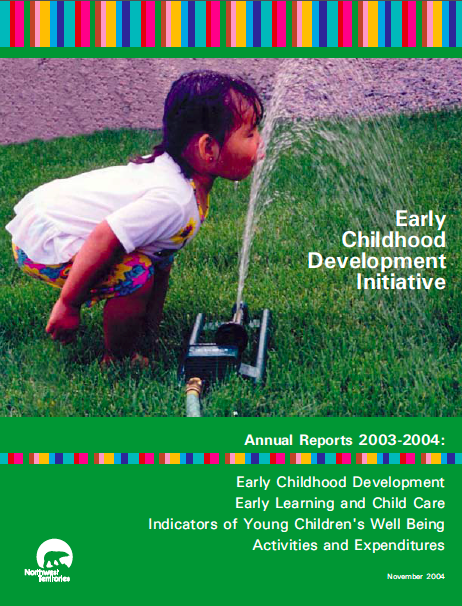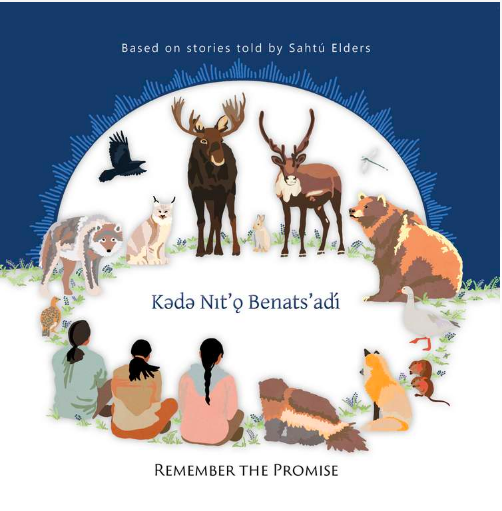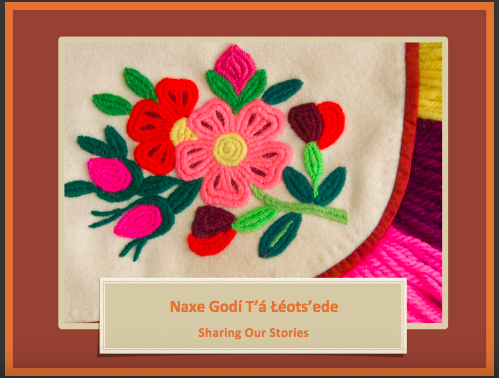Kǝdǝ Nıt’ǫ Benats’ adı́ - Xǝdǝ Rı́hęt’ǫ Herats’ǝ́dı (Remember the Promise)
From Introduction: "In March 2013, elders, Dene language specialists and others got together for a workshop to talk about how the story of species at risk can be understood through the language and stories of Dene and Métis. They agreed that the main people who need to work on these things are the present and future youth of the Sahtú Region. This book is dedicated to the workshop participants, and to the youth who are the future stewards of the land.
The first part of this book is a story, Remember the Promise, with Dene words. The meanings of those words can be found in the glossary (page 18). The second part includes more details about the workshop and the terms that were worked on in the dialects of Délı̨nę, Tulı́t’a, and K’asho Got’ı̨nę. The last part has more information about species at risk in the NWT.
Keeping the Dene language alive is part of keeping alive people’s sacred and respectful relationships with other living things. We hope that this book will encourage people to speak and understand the language of this land, the language of the ancestors. Through the language, we are sure to remember the promise."
Read more about this project, and access the full text in multiple languages, on the Remember the Promise page on the SRRB site.
Sahtú Renewable Resources Board. Kǝdǝ Nıt’ǫ Benats’adı́, Remember the Promise. Compiled by Betty Harnum and Deborah Simmons, with a foreword by Michael Neyelle, 2014.
Naxe Godı́ T’á Łéots’ede, Sharing our Stories
This document is a public collections record featuring stories and photographs of objects from the Sahtú region. It was developed between 2013 and January 2014 by the Prince of Wales Northern Heritage Centre (PWNHC) and:
Elders: Maurice Mendo, Camilla Tutcho, and Vicki Orlias
Interpreter: Lucy Ann Yakelaya
Students: Dalton Takazo, Darren Horassi, Carmen McNeely, and Chantelle Orlias
Chaperones: Jessie Campbell and Richard Andrew
Sponsors: The PWNHC and Education, Culture, and Employment (GNWT)
Workshop Coordinator: Wendy Stephenson
Naxe Godı́ T’á Łéots’ede, Sharing our Stories documents a workshop wherein Elders, Students, and other Sahtú region participants gathered to give oral histories to objects in the Prince of Wales Northern Heritage Centre (PWNHC) collection. Objects such as mukluks were identified in as many different Sahtú dialects as possible, Délı̨nę, Tulı́t’a, and Fort Good Hope. Students listened to elders talk about their purpose and history, and Elder’s quotations were preserved by the PWNHC in this record.
Access this Resource:
The PWNHC has the full text of this book and other language communities' projects on their website: https://www.pwnhc.ca/collections/sharing-our-stories/
Prince of Wales Northern Heritage Centre and Sahtú Dene Elders. Naxe Godı́ T’á Łéots’ede, Sharing our Stories. Yellowknife, 2014.
From the ground up
This short paper provides an overview of Yukon, NWT, and Nunavut literacy non-profit organizations and coalitions. In general, these organizations attempt to work collectively, with families, communities, and intergenerational groups. Literacy programs depend on an interested party in the community working as a liaison, and usually are integrated into existing programming at libraries, early childhood programs, with health and recreation activities, or in other settings.
Abstract:
Community-based family literacy programmes tend to be neglected in a policy environment that ties funding for literacy programmes to work outcomes. In these circumstances many communities tackle their own local challenges, and the literacy coalitions in northern Canada are good examples of local communities taking a lead. Aggie Brockman discusses how they do it.
Access this Resource:
This resource is not publically available, but can be purchased from Fine Print.
Brockman, Aggie. “From the Ground Up.” Fine Print 36, no. 3 (2013): 8-11.
We are all treaty people: The contemporary countenance of Canadian Curriculum Studies
Chambers begins with stories about her Irish and Scottish-Canadian heritage, and her ancestors’ emigration from the United Kingdom to its colony in Canada. Through the lives of her grandparents and other relatives, Chambers outlines a short history of those settlers who moved to the North, their reasons for going, and the types of landscapes they encountered. The history of Canada’s use of northern resources is told at the same time: the gold rush, the northern treaties, and the interactions between Northern settlers and Indigenous peoples. It is a personal exploration of the links between curriculum studies, heritage, history, landscapes, and responsibilities.
Abstract:
I’m a commoner by birth, with no inherited rights of property or privilege other than race (color white) and language (English): Irish peasants onmy mother’s side, landless Scots on my father’s side. My mother cursed my father: “You, son of a coal miner!” The men in my father’s family went underground to mine shale, not coal, (AAPG n.d.), a distinction that my father was careful to point out, and which my mother was careful to ignore. My father’s retort was to call my mother “Irish,” with all the disdain of a curse, one that accounted for her various shortcomings: a voice too loud, a tongue too quick, and manners too coarse. One March 17th, long after my mother had died, my father phoned from Vancouver to wish me a happy St. Patrick’s Day, adding, “Well, you are Irish!” A quick reminder of what is uncommon between us. Although, both my 90-year-old father and I know that lowland Scots and northern Irish have bonked back and forth across Irish Channel since the Battle of the Boyne. Such national leapfrogging makes purity of identity based solely on nationality fictional and hard to defend, though defend, my ancestors did. While my father’s father, Thomas Chambers, was born in Scotland, his father was born in County Antrim, Ireland. However, Thomas Chambers would become enraged at the mere insinuation that he was Irish.
Access this Resource:
Chambers, Cynthia. “‘We are all treaty people’: The contemporary countenance of Canadian Curriculum Studies.” Reconsidering Canadian Curriculum Studies: Provoking Historical, Present, and Future Perspectives, edited by Nicholas Ng-A-Fook and Jennifer Rottman, 23-38. New York: Palgrave Macmillan, 2012.
Promoting well-being through land-based pedagogy
This paper is based on an evaluation of Dechinta, Bush University’s first semester, run by Thea Luig in 2010. The evaluation consisted of semi-structured interviews with instructors and students, along with a critical reflection from the founder and manager of Dechinta (second and third authors, respectively). Dechinta aims to promote experiential, land-based learning based on “Indigenous values and ways of relating to the environment” (14).
From the variety of evidence collected from their evaluation, the authors conclude that Dechinta has enormous potential to be a model of land-based instruction. Students have personal, embodied, and experiential learning experiences that lead to “unique understanding… tangible skills, personal growth, and high knowledge retention” (21). It faces the challenge of funding, and dogmatic understandings of what higher education entails. In addition, the authors call for further research to understand learning and well-being in relational contexts.
Abstract:
In June 2010 “Dechinta” - Bush University Centre for Research and Learning ran their first semester of land-based and university-accredited courses. During a three-week pilot session at a remote location in the Canadian Northwest Territories, students from Aboriginal and non-Aboriginal background learned about health promotion, the history of their people, governance, creative writing, and sustainable technologies. Resident Elders, cultural experts, university professors, and artists taught in collaboration through fireside lecturing, writing, and speaking assignments, travelling out on the land, gathering wood, harvesting, moose hide tanning, making dry fish, and more. Experiential learning that engaged students on intellectual, emotional, and physical levels created awareness of various emotional difficulties, their causes, and their effects on health among participants. The experience of interrelatedness with the land and the group, sharing these experiences in storytelling and writing, working and being on the land proved effective in addressing and emotionally integrating these issues. The Elders present contributed to this process by modeling appropriate behaviour in the face of difficulties and conflict. This paper intends to show the varied relationships between the pedagogy of northern Aboriginal people and the promotion of lifelong well-being. It will relate the experience of Dechinta with a theoretical discussion drawing on critical pedagogy, cultural anthropology, and psychology.
Access this Resource:
This PDF is not available open access, but can be purchased from the Journal in its bookstore.
DOI: https://doi.org/10.18848/2156-8960/CGP/v01i03/41181
Luig, Thea, Erin Freelnd Ballantyne, Kyla Kakfwi Scott. “Promoting Well-Being through Land-Based Pedagogy.” The International Journal of Health, Wellness and Society 1, no. 3 (2011):13-26.
Evaluating Aboriginal Curricula using a Cree-Métis Perspective with a regard towards Indigenous knowledge.
Ouellette outlines the history and goals of Aboriginal education and curricula, in part by surveying and assessing the (over 48) Aboriginal curricula currently in use in Canada. He also provides an overview of the debates surrounding Indigenous education, including the degree to which it should be integrated with existing Canadian institutions, and which level of government should control Indigenous curricula and their implementation. Within this dissertation, Ouellette assesses Dene Kedǝ curriculum. He estimates that 30% of the supplementary material promised for teacher support was missing at the time of writing, and that teachers also lacked clear guidelines for student assessment, objectives, and evaluation materials. He comments that while strong Dene values are clear throughout the Dene Kedǝ curriculum documents, they need more additional support and materials to be practical for teachers to implement.
Access this Resource:
Read this thesis open access from Collections Canada.
Read this thesis open access from Université Laval.
Ouellette, Robert-Falcon. Evaluating Aboriginal Curricula using a Cree-Métis Perspective with a regard towards Indigenous knowledge. Doctoral Thesis, Université Laval, 2011.
Resources for Teaching Aboriginal Languages in the Northwest Territories: An Annotated Bibliography
This document is an immensely useful resource for teachers and students of Indigenous languages in the Northwest Territories. It provides a collection of language books published in: Cree, North Slavey, South Slavey, Chipewyan, Tłįchǫ̨, and Gwich’in. Teaching and Learning Centres, other Community Language Groups, and numerous school boards and Divisional Education Councils contributed to its creation, with sponsorship from the GNWT and the Government of Canada through the Department of Canadian Heritage.
The Dene Godǝ, North Slavey portion of the annotated bibliography contains numerous resources that are not already referenced in this Dene Kedǝ to Dene Ts’ı̨lı̨ database.
Access this Resource:
The Yamózha Kų́ę́ Society has made this resource available open access here.
Visit the SSDEC's full list of resources, including other annotaded bibliographies: https://www.ssdec.net/aboriginal-language
Kaulback, Brent. Resources for Teaching Aboriginal Languages in the Northwest Territories: An Annotated Bibliography. Hay River and Fort Smith: Yamózha Kų́ę́ Society/South Slave Divisional Education Council, 2010.
A Journey Toward Inter-cultural Awareness
This paper focuses on the importance of inter-cultural awareness in northern teachers. The authors discuss Dene Kede curriculum as an educational tool that contextualizes the NWT’s K-6 curriculum classes (English Language Arts, Math, Science, etc.) with a focus on the self and its fundamental relationships. Learning the Dene way is experiential and connected with the land, and understanding/implementing this is often a challenge for new teachers from the south.
Grieg and Norwegian present Dene Kede: Trails to Becoming, an interactive CD-ROM game intended to help teachers learn about traditional Dene culture and ways to integrate Dene Kede curriculum into their classes. They are introduced to the Dene Kede educational model, and they are also encouraged to identify their own world views and biases in a set of exercises. The authors suggest that one weakness of this approach is the absence of shared learner outcomes and feedback.
Abstract:
The purpose of the Dene Kede: Trails to Becoming is to introduce teachers new to the Northwest Territories to the Dene, who are members of Canada's First Nations. Through a CD-ROM they will embark on a journey of discovery toward intercultural awareness and sensitivity. They will learn about the traditional Dene culture within the context of the Dene ways of knowing and will explore ways of integrating Dene Kede into their classroom lessons. The Dene Kede curriculum represents a very important step in the evolution of integrating the Dene culture into the classrooms of the Northwest Territories.
Access this Resource:
This conference paper is not available open access, but can be purchased from the Learning and Technology Library.
Grieg, Debra, and Gladys Norwegian. “A Journey Toward Inter-cultural Awareness.” Chesapeake: World Conference on Educational Media and Technology, 2010.
Language Nest Evaluation Report
This evaluation of Language Nests in the Northwest Territories is a detailed overview of the Indigenous language immersion programs that were folded into pre-existing licensed day cares and Head Start facilities beginning in 2003. The evaluation process had two steps: first, a workshop with language nest staff from all 18 nest sites (which included at least one from representative from each NWT language region). This was meant to introduce the staff to the purpose of evaluation and incorporate their feedback into the evaluation framework, which covered both process/program delivery and outcome/language acquisition.
The authors identify numerous strengths of the language nest program, primarily surrounding increased awareness of language and culture for participants and communities, willingness to pursue learning, and intergenerational transmission. Children, parents, elders, staff, and communities interacted positively and productively with the language nest program. The programs also encountered challenges, namely: a lack of central administrative support, staffing and turnover, unavailability of training, no core or multi-year funding, incomplete immersion, no curriculum, parental concerns about bilingualism confusing their children, and no evaluative standards. The Language Nest evaluation made numerous recommendations to help mitigate these concerns. At least two nests existed in the Sahtú region, including one in Délı̨nę and one in Fort Good Hope.
Access this Resource:
This report is not currently publically available.
Hume, Sharon, Deborah Rutman, and Carol Hubberstey. Language Nest Evaluation Report. Department of Education, Culture and Employment: Yellowknife, 2006.
Annual Reports 2003-2004: Early Childhood Development; Early Learning and Child Care; Indicators of Young Children’s Well Being Activities and Expenditures.
This report provides an overview of all manner of early childhood services and initiatives in the NWT, including health, education, etc.
A small section on Language Nests (preschools where lessons are conducted in Indigenous languages) on page four provides some extra information about their implementation in the Northwest Territories at this time. This was the primary interest of Sahtú region researchers in this report, as it was found during a literature review on Language activities in the NWT.
- Language Nests included elders, Early Learning and Child Care workers, production and use of materials and activities in Aboriginal languages, and the involvement and commitment of the community.
- Language Nests were situated in pre-existing licensed early learning and child care settings.
- 2003/2004 had 18 Language Nest programs in the NWT. This year focused on expanding resource materials in more of the official languages.
- Staff were trained in language and identity, language acquisition, and “structuring language components into daily child care routines.”

Access this Resource:
Government of the Northwest Territories Department of Education, Culture and Employment. Early Childhood Development; Early Learning and Child Care; Indicators of Young Children’s Well Being Activities and Expenditures. Yellowknife, November 2004.




 Phone: 867-374-4040
Phone: 867-374-4040 Email:
Email: